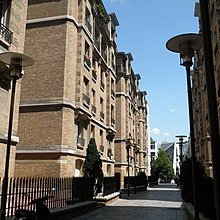Public housing in France: Difference between revisions
m →Statistical data: Fix CS1 unknown parameter errors using AWB |
|||
| Line 64: | Line 64: | ||
* The [[HLM]], ''Habitations à loyer modéré'', can be private or public. They are the most common and are housing an estimated thirteen million people. |
* The [[HLM]], ''Habitations à loyer modéré'', can be private or public. They are the most common and are housing an estimated thirteen million people. |
||
* Subsidized housing (built by private sector) |
* Subsidized housing (built by private sector) |
||
* Cooperativeshi guys how are you cx |
|||
* Cooperatives |
|||
===Effect on economy=== |
===Effect on economy=== |
||
Revision as of 18:01, 29 April 2014

Public housing in France or social housing in France (French : logement social, also called by generalization Habitations à loyer modéré or HLM) is a central, local or social program designed to provide subsidized assistance for low-income and poor people.
Statistical data

| Country | Number of residences per 1,000 inhabitants[1] |
|---|---|
| Netherlands | 147 |
| Austria | 103 |
| Norway | 102 |
| Denmark | 102 |
| Sweden | 95 |
| United Kingdom | 85 |
| France | 69.2[2] |
| Germany | 27 |
| Italy | 18 |
| Spain | 3 |
France had 4.508 million HLM on January 1, 2010 (except overseas regions of Martinique and Guyane).[3]
History

France has a long tradition of social and state intervention in the housing market. In 1775, the Royal Saltworks at Arc-et-Senans was built with a part dedicated to house workers.[4] In the 19th century the cités ouvrières (company towns) appeared, inspired by the Phalanstère of Charles Fourier.[5] After World War II, the population increased at a rate previously unknown, the rural exodus increased, while war damage had reduced the number of houses in many cities. Rental prices dramatically rose, and the government made a law in 1949 to block them, effectively ending the economic benefits of housing investment. Additionally, construction was strictly regulated which made building very difficult without political support.

The government launched a huge construction plan, including the creation of new towns ("villes nouvelles") and new suburbs with HLM (Habitation à Loyer Modéré, "low-rent housing"). The state had the money, the legal means to acquire the land and could provide some advantages to the companies that built its huge housing complexes of hundreds of apartments. Quality was also effectively regulated, resulting in decent or even top quality housing for the standard of the time (this was in the 1950s and 1960s). Political forces used the HLM weapon effectively, for the family that was given the opportunity to have an HLM could only be thankful to its local mayor; besides, a "communist" mayor was always happy to have as much HLM as possible, for their tenants were poorer and more likely to vote for him, while its "gaullist" neighbour was as much happy to see them leave.
HLM construction was also a major source of political financing : building companies had sometimes to pay back the political party of the mayor that launched an HLM program. This resulted in corruption scandals.
A law of 1998 made it an obligation for every town in France to have at least 20% HLM.[citation needed]
The different kinds of social housing
- The HLM, Habitations à loyer modéré, can be private or public. They are the most common and are housing an estimated thirteen million people.
- Subsidized housing (built by private sector)
- Cooperativeshi guys how are you cx
Effect on economy
This article is written like a personal reflection, personal essay, or argumentative essay that states a Wikipedia editor's personal feelings or presents an original argument about a topic. (February 2013) |
The social housing programs in France have an obvious positive effect on the consumption of the households that benefit from them.[6] There is no consensus about the influence on the rents of the private sector and on the prices of real estate.
See also
Notes and references
- ^ Template:FrJ. Ch (13 June 2008). "L'Institut Montaigne propose de réformer les loyers du secteur HLM". Les Échos.
{{cite journal}}: Cite has empty unknown parameter:|text=(help) - ^ Template:FrMEEDDM, Les organismes de logement social, June 2009.
- ^ Template:FrChauvot, Myriam (January 2011). "Le parc HLM compterait 4,5 millions d'habitations au 1 janvier 2010". Les Echos. Retrieved 18 April 2011.
- ^ "Saline Royale - Le monument". official website of the EPCC Saline Royale. Retrieved 18 April 2011.
- ^ Monin, Emmanuel-Yves. Chez les Bâtisseurs d'Utopies. Monin.
- ^ le Blanc, David (December 2001). "The Effect of Public Social Housing on Households' Consumption in France" (PDF). Journal of Housing Economics. 10 (4): 429–455. doi:10.1006/jhec.2001.0300. Retrieved 18 April 2011.
{{cite journal}}: Unknown parameter|coauthors=ignored (|author=suggested) (help)
External links
- Template:FrLes organismes d'habitation à loyer modéré at Cour des Comptes
